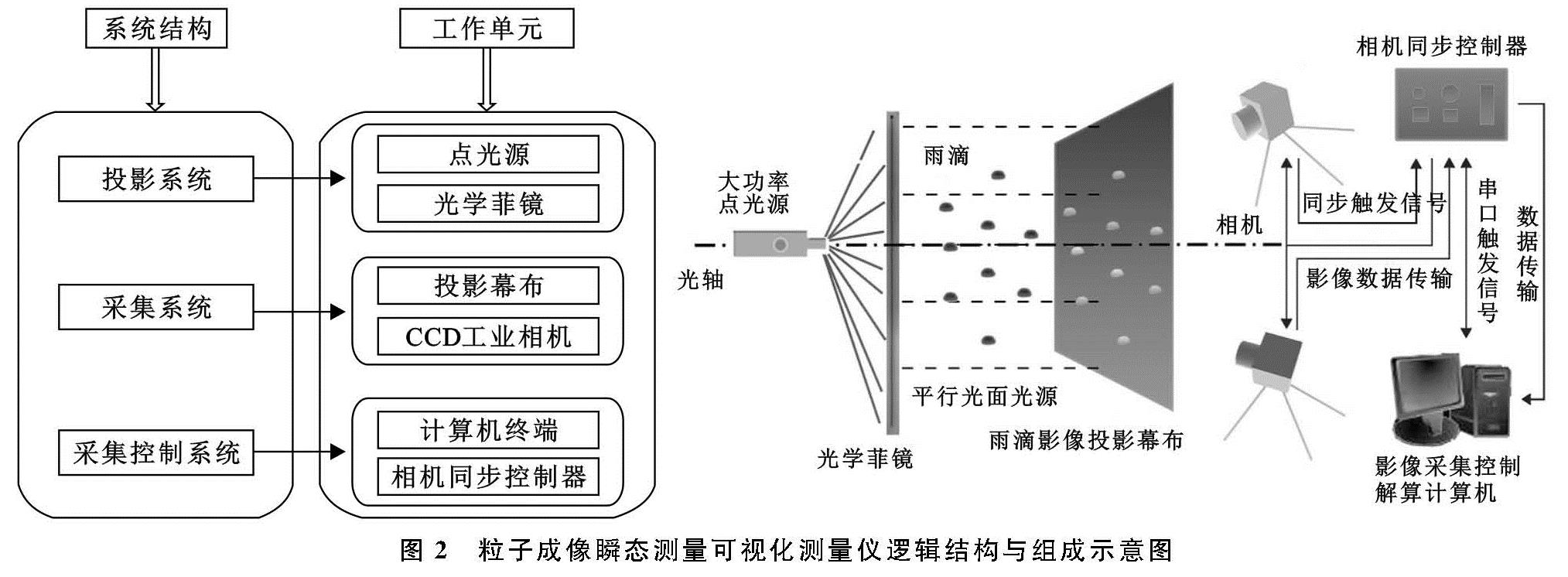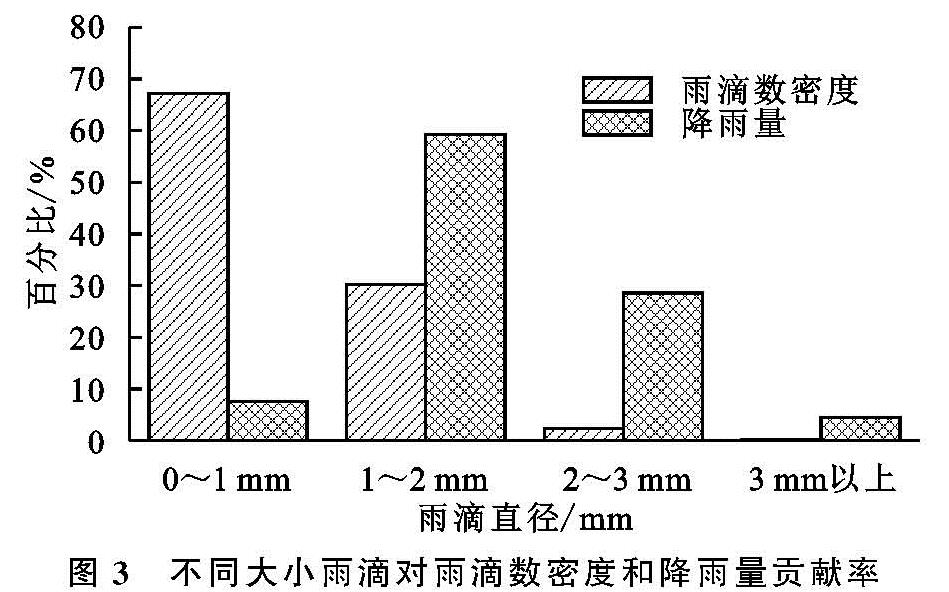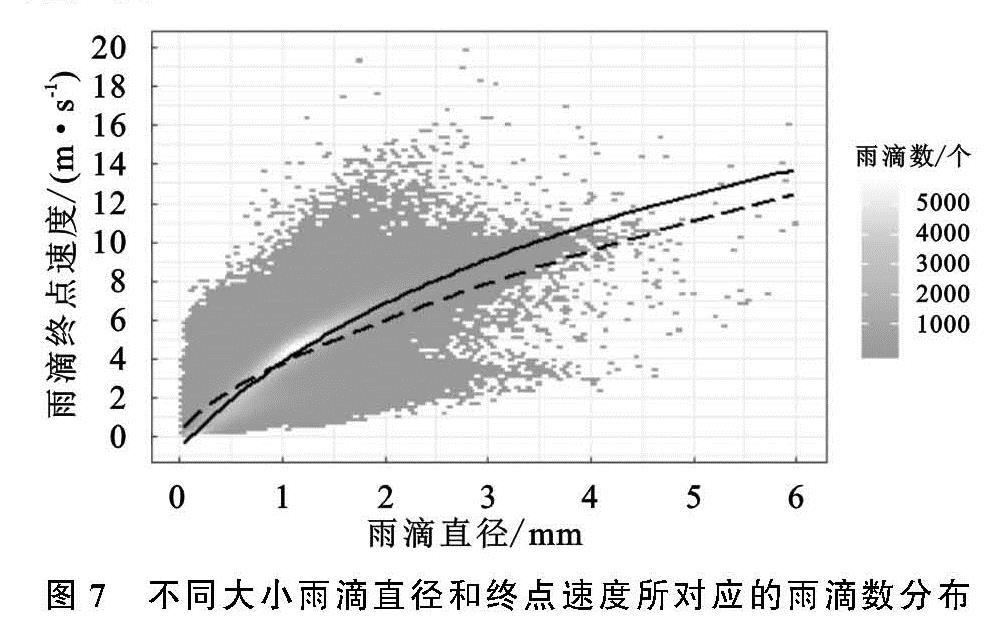不同地区的雨滴物理特性具有一定的差异性,本次降雨过程中雨滴直径的平均值为1.08 mm,低于我国南京地区(1.40 mm)[24]和珠海地区(1.47 mm)[25]自然降雨雨滴直径,但与我国北京地区自然降雨雨滴直径(1.04 mm)[18]相比差异较小。气温及暴雨持续时间可能是引起本研究区与两地自然降雨雨滴直径差异的原因之一。以往有研究表明,高温地区雨滴直径大于温度相对较低的地区,且持续不到1 h的暴雨所产生的雨滴直径相比持续多小时的降雨产生的雨滴直径要大得多[26]。南京、珠海地区年均气温高于本研究区,并且多为短历时暴雨,所以其自然降雨雨滴直径与本研究区存在一定差异。就雨滴数密度而言,本研究中雨滴数密度(141.63个/m3)与印度半岛南部(349.2个/m3)[27]相比明显偏小,但与Tang等[18]对北京地区的研究结果相比,雨滴平均直径和雨滴数密度(174.7个/m3)均相差较小。这种空间差异可能是由于地理位置和气候条件的不同而造成的。此外,本研究中小雨滴(0<D≤1 mm)数量较多,占到雨滴数密度的67.22%。Carter[26]同样发现,直径约为1 mm的雨滴最为常见; Tang等[18]对北京、张北、阳江3个地区降雨研究发现,层状雨亦以1 mm的雨滴为主。相比之下,本研究中大雨滴(D>3 mm)占比极小,仅占到雨滴下落总数的0.20%。这是因为雨滴在下落过程中受到局部上升气流或下降气流的影响,会发生空气动力学破裂与碰撞破裂,进而限制了雨滴的大小。相较于空气动力学破裂,碰撞引起的雨滴破裂对雨滴大小的影响更强,其中大雨滴的主要消耗方式为包状破裂[28]。此外,该研究区位于两大山系的交汇地带(图1),山地对湿润空气的抬升作用可提供足够的凝结水,进而产生大量小雨滴[29]。
将宁强地区该次降雨过程中雨滴谱与山西汾阳地区雨滴谱比较发现[30],实测雨滴谱谱型都呈单峰状,但汾阳地区雨滴谱峰值直径大于宁强地区雨滴谱峰值直径。不同雨强下两地雨滴谱分布情况相似,当降雨强度较小时,雨滴谱宽度较窄; 当降雨强度逐渐增加后,雨滴谱宽度明显变宽,这表明随着降雨强度的增大,直径较大的雨滴亦在不断增加。在雨滴直径较小时,不同降雨强度下雨滴谱差异较小,但随着雨滴直径的增大,不同降雨强度下雨滴谱差异增大,由此判断降雨强度的增大与大直径雨滴的存在和雨滴谱的变异有关[31]。分析降雨强度与雨滴数密度和雨滴平均直径的关系可知,随着降雨强度的增大,雨滴数密度和雨滴平均直径均呈增大趋势,但雨滴平均直径的增大趋势逐渐趋于稳定。该结果说明在本次降雨过程中,小雨和中雨的降雨强度受雨滴数目和雨滴大小的共同影响,但降雨强度逐渐增大后,其主要影响因素发生改变,仅为雨滴数目。对比Zhang等[25]对我国南方降雨分析发现,雨滴平均直径随降雨强度变化趋势的研究结果与本研究相似,而降雨强度与雨滴数密度呈幂函数关系,与本研究结果不同,究其原因主要是由于雨滴下落过程中碰并和破裂发生的频率更高所引起的。关于雨滴数密度和平均直径与雨强关系的研究结果表明,较大的降雨强度条件下,雨滴的碰并与破裂达到相对平衡状态。在这种平衡状态下,雨滴平均直径随降雨强度的增大而趋于稳定,引起降雨强度增大的主要因素为雨滴数密度,而非雨滴平均直径,这说明自然降雨雨强的变化对雨滴数目比雨滴大小更敏感。
雨滴终点速度随雨滴直径增大而变化的过程中,其增大趋势逐渐减缓。这种趋势可能是由于雨滴直径的增大,导致其在下落过程中形状的改变使自身所受阻力逐渐增大,进而使得雨滴终点速度增大的趋势逐渐减缓[32]。通常情况下,较大的雨滴比小雨滴具有更大的终点速度,诸多学者通过实验室模拟和实地测量提出了一系列经典的雨滴终点速度计算公式,以表示雨滴直径与终点速度间的对应关系,但在实际测量中雨滴直径与终点速度并非呈一一对应的关系。Montero-Martinez等[33]研究表明,由于雨滴碰并和破裂的影响,使得小雨滴具有过大终点速度,而较大的雨滴具有过小终点速度。Pinsky等[34]通过数值模拟证明了空气湍流可对雨滴终点速度产生大幅度影响,雨滴的碰并和破裂与其终点速度大小密切相关。这种现象可能是由于雨滴碰撞结合在一起形成更大的雨滴,其降落速度会与其中较大雨滴的降落速度保持一致,进而导致碰并后雨滴的终点速度小于相应直径的终点速度; 同样,当雨滴在下落过程中破裂形成更小的雨滴后,将保持原来的速度下降,使得破裂后雨滴终点速度大于其直径相对应的终点速度[33]。将本研究拟合的关系曲线与常用经验关系曲线对比可知,本研究拟合的关系曲线与其存在一定的差异。这种差异可能是由于气压与气候的不同导致空气密度、空气黏滞阻力等均存在差异,最终影响雨滴终点速度大小[35-36]。对于大小相同的雨滴,尤其对于较大的雨滴,其终点速度随空气密度减小而增大[37]。常用经验关系曲线均是基于标准大气压(1 013 hPa)条件下得来的,而宁强县体育场海拔高程约为803 m(图1),与其相对应的气压约为915 hPa。由孙学金等[35]得研究发现相同直径雨滴的终点速度随着气压的减小呈增大趋势,并且随着雨滴直径的增大,该趋势也逐渐增加,与本文的研究结果相似。
由以上讨论可知,雨滴特征会因地理位置和气候条件的不同而具有很大差异。作为水力侵蚀的主要影响要素,雨滴撞击土壤表面产生的土壤颗粒会沉积于土壤表面或通过地表径流进一步运输,其溅蚀能力主要取决于自身的大小和终点速度。雨滴特征差异使得自然降雨条件下溅蚀的研究局限于特定地区条件。通过对雨滴大小和终点速度直接观测可提高降雨参数计算的精确度,有利于溅蚀的研究。因此,连续、直接测量雨滴大小和终点速度,获取详细的雨滴特征资料为溅蚀发生过程的研究提供了数据支持,并为特定地区溅蚀量的估算奠定了基础,这对土壤侵蚀的研究具有重要意义。











